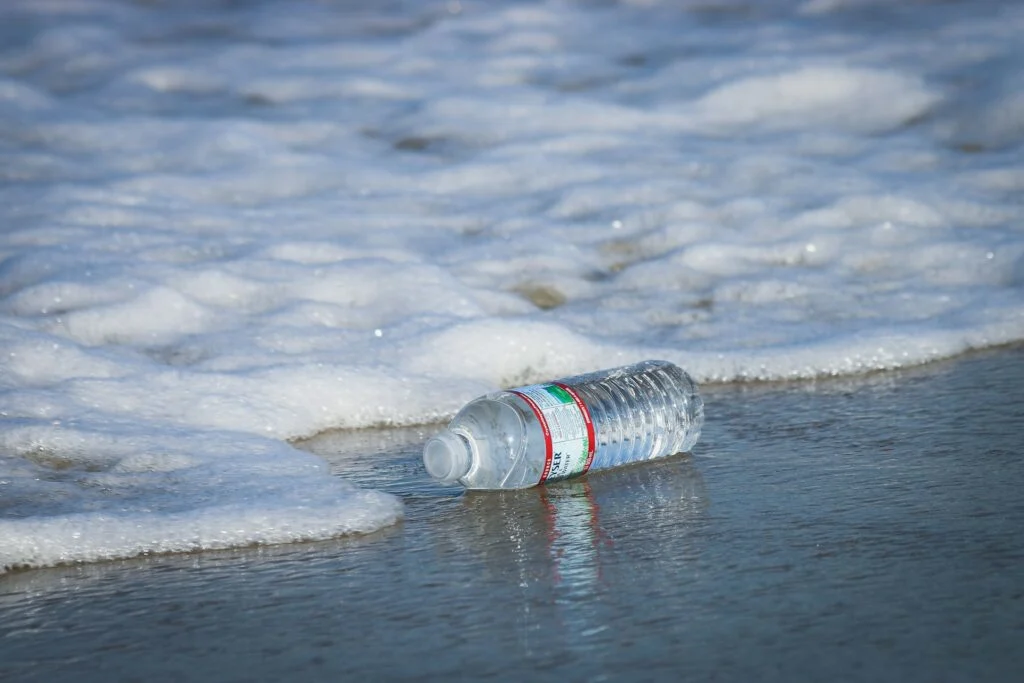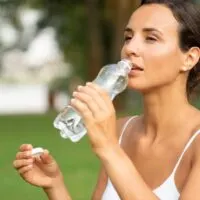Ever had that moment where you take a long, satisfying gulp from bottled water, believing you’re giving your body the pure hydration it craves? Well, hold onto that bottle, because recent studies are making waves, revealing unexpected chemicals and contaminants in bottled water. From microscopic plastic particles to traces of medication, the contents of that seemingly pristine bottle might be more than just H₂O.

A Revelation on Lurking Contaminants in Bottled Water
A study by the Environmental Working Group (EWG) examined the chemical makeup of several bottled water brands, unearthing a cocktail of surprising ingredients.
The lab tests, which included 10 brands, detected an average of eight contaminants per brand. These revealed unexpected elements, including:
- Caffeine
- Acetaminophen, a pain reliever
- Fertilizers
- Solvents
- Plastic-derived chemicals
- Strontium, a radioactive substance
- Trihalomethanes
The spotlight was cast particularly on two brands: Sam’s Choice, sold by Wal-Mart, and Acadia from Giant Food supermarkets. Both exhibited chlorine byproducts known as trihalomethanes at levels exceeding California’s standard, a matter of concern given the substance’s links to cancer.
While some of the contaminants might have leached from the very plastic bottles housing the water, others bore a disconcerting resemblance to common tap water pollutants. This discovery places a question mark on the popular belief that bottled water is inherently purer or safer than its tap counterpart. https://www.youtube.com/embed/txni6ssqhws?si=vofczXNJoxeBqpHs
The Concern With Chlorine in Drinking Water
Chlorine has been used as a primary disinfectant in water treatment for over a century. While it plays a crucial role in eliminating harmful pathogens and making water safe for consumption, there are emerging concerns regarding the byproducts it forms when reacting with organic materials in the water.
- Formation of Trihalomethanes (THMs): One of the primary concerns with chlorine disinfection is the formation of THMs. Studies have found a potential association between long-term exposure to THMs and an increased risk of various types of cancer, including bladder and colon.
- Health Impacts of Chlorine Byproducts: Apart from THMs, chlorine can form other disinfection byproducts (DBPs) like haloacetic acids (HAAs). Some studies indicate potential reproductive and developmental risks associated with exposure to high levels of HAAs.
- Impact on Respiratory and Skin Health: Chlorinated water, especially when used in showers, can lead to the release of chloroform, a type of THM. Inhaling chloroform over extended periods can exacerbate respiratory issues like asthma. Additionally, water with high chlorine content can cause skin and eye irritation.
- Chlorine and Birth Defects: Research has indicated that exposure to high levels of chlorine or its byproducts might be associated with certain birth defects. A study published in Environmental Health found a potential link between prenatal exposure to THMs and a slight increase in the risk of ventricular septal defects, one of the common congenital heart defects.
- Alteration of Taste and Smell: Apart from health concerns, chlorine and its byproducts can influence the sensory properties of water. A distinct chlorine taste or smell might make the water less palatable for some individuals.
A Deeper Insight into Contamination in Bottled Water: SUNY Study
In a landscape where consumers are increasingly looking for clean sources of drinking water, EWG’s findings aren’t the only report shedding light on contaminants in bottled water.
A comprehensive analysis by the State University of New York (SUNY) in Fredonia unveiled alarming statistics about the presence of plastic in popular bottled water brands. Commissioned journalism initiative Orb Media, the SUNY research team delved deep into 259 bottled water samples from 11 leading brands, which were sourced from 19 different locations in nine countries, including the US, China, Brazil, and Mexico.
The findings were both surprising and concerning:
- A staggering 93% of the bottled water samples contained detectable plastic particles.
- On average, each liter of water contained 325 plastic particles.
- Some samples had concentrations as high as 10,000 plastic particles per liter.
- Out of the 259 bottles tested, a mere 17 were devoid of plastics.
- The predominant plastic fragment identified was polypropylene, the same material used in the manufacturing of bottle caps.

Comparatively, the study revealed that bottled water contained approximately double the amount of plastic particles as found in their earlier research on tap water.
The brands tested in this study included global giants:
- Aqua (Danone)
- Aquafina (PepsiCo)
- Dasani (Coca-Cola)
- Epura (PepsiCo)
- Evian (Danone)
- Gerolsteiner (Gerolsteiner Brunnen)
- Minalba (Grupo Edson Queiroz)
- Nestle Pure Life (Nestle)
- San Pellegrino (Nestle)
- Wahaha (Hangzhou Wahaha Group)
While the SUNY research raises questions about the physical integrity of bottled water, the EWG study undeniably emphasizes the chemical purity aspect, both pointing towards a pressing need for more rigorous standards and transparency in the bottled water industry.
The Dangers of Microplastics in Drinking Water
The term “microplastics” refers to tiny fragments of plastic, typically less than 5mm in size, that have made their way into our environment, including our food and water sources. Their presence in bottled water has drawn significant attention, leading to widespread concern about their potential impact on human health.
- Chemical Leaching: Once ingested, microplastics can potentially leach chemicals, such as bisphenol A (BPA) and phthalates, which are known endocrine disruptors. These chemicals can interfere with the body’s hormone system, potentially leading to reproductive issues, neurological problems, and increased cancer risks.
- Carrier for Toxins: Microplastics have a knack for absorbing environmental contaminants, like pesticides and heavy metals, from surrounding waters. When ingested, these toxin-laden particles may introduce these pollutants into the human body, amplifying their potential harmful effects.
- Physical Damage: Even though microplastics are small, they can still cause physical harm. Sharp or irregularly shaped particles might damage the delicate tissues of the digestive system, leading to inflammation or other issues.
- Bioaccumulation: As with marine life, there’s concern about the bioaccumulation of microplastics and associated toxins in the human body. Over time, regular consumption of contaminated water or food could lead to a buildup of these particles and chemicals, increasing the risk of associated health problems.
- Unknown Long-Term Effects: The science surrounding microplastics is still in its early stages. There may be long-term effects of microplastic ingestion that we’re not yet aware of. As studies continue, our understanding of these potential threats may evolve.
How to Minimize Exposure to Microplastics and Chemicals in Bottled Water
With growing concerns about the presence of chemicals and microplastics in bottled water, many people are seeking ways to protect their health without compromising hydration. Fortunately, there are proactive steps you can take to ensure the water you drink is as pure as possible and to minimize your exposure to unwanted contaminants.

- Choose Glass or Stainless Steel: When possible, opt for beverages sold in glass containers or stainless steel rather than plastic bottles. These materials don’t leach chemicals and are free of microplastics.
- Invest in a Quality Water Filter: For home use, a high-quality water filtration system can help reduce contaminants in tap water. This will not only reduce the need for bottled water but also ensure that the water you consume is cleaner.
- Look for BPA-Free Plastics: If you must choose plastic, look for bottles labeled as BPA-free. While they might still have other chemicals, they won’t contain BPA, which is a known endocrine disruptor.
- Avoid Reusing Disposable Bottles: If you purchase water in a plastic bottle, try not to refill and reuse it multiple times. Over time, more and more chemicals can leach from the plastic, especially if the bottle is exposed to sunlight or heat.
- Educate Yourself: Keep up to date with brands that have faced scrutiny over water quality and make informed decisions when purchasing. Remember, just because water is clear doesn’t mean it’s free from microplastics or chemicals.
- Reduce Plastic Consumption: Every bit helps. By reducing overall plastic consumption, you’re not only reducing potential personal health risks but also helping decrease environmental pollution. Use cloth bags, refuse straws, and buy products in bulk where possible.
Remember, while it’s essential to be conscious and cautious, it’s equally vital to stay informed and proactive. By taking simple steps and making informed choices, you can significantly reduce the potential risks associated with bottled water consumption.



